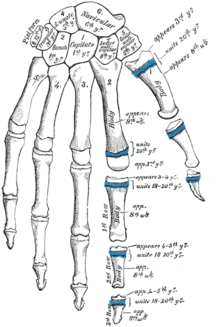Finger bones
The finger bones ( lat. Ossa digiti manus ) are the bony supporting elements of the fingers . In mammals , every fully developed finger has three bony support elements, which are called the phalanx proximalis , media and distalis ("near, middle and distal phalanx bones"), also phalanx I, II and III; (from ancient Greek phalanx "battle line of warriors", "tree trunk", "roller", or "roll"). The human thumb has only two phalanges. The joints between the metacarpal bones and the proximal phalanx and the phalanx bones are the finger joints .
Structure in humans
The structure of the finger bones is typical of tubular bones . A distinction is made between proximal and distal finger bone base ( base phalangis ), body ( corpus phalangis ) and head ( caput phalangis ).
The finger bone base of the phalanx proximalis has a concave joint surface for the metacarpophalangeal joint, the joint surfaces of the base of the lower phalanx bones a sagittal guide comb. The articular surfaces of the head at the proximal and media phalanx are known as the trochlea . The head of the distal phalanx is flattened and has a roughness on the palm side, the tuberosity phalangis distalis manus , to which the holding ligaments of the fingertips ( retinacula cutis ) attach.
Comparative anatomy
The number of phalanx bones of the individual fingers in humans (2-3-3-3-3) corresponds to the basic structure of mammals , in primitive reptiles one finds the phalangeal formula 2-3-4-5-3. There are stronger modifications within the mammals in the whales , in which additional finger joints are formed ( hyperphalangia , formula 2-12-8-1).
In ungulates , the three phalanx bones are called the fetlock , corolla and coffin bone ; in predators , the terminal phalanx is also known as the "claw bone". Back of hand side is located at the base of the phalanx media in the four-footed mammals an extension (extensor process) for attachment of the extensor digitorum lateralis and palm side a roughness ( Tuberosits flexoria ) for attachment of the flexor digitorum superficialis muscle .
The phalanx distalis shows clearer differences to humans due to the different footing in the quadruped mammals. In animal anatomy, a distinction is made between a joint surface ( facies articularis ), a wall surface ( facies parietalis ) and a sole surface ( facies solearis ). An articular surface for the navicular bone ( facies articularis sesamoidea ) is located on the joint surface of the phalanx distalis . The sole surface carries the attachment point for the flexor digitorum profundus , as flexorium tubercle (ruminants, carnivores, pigs) or facies flexoria (horse) is called. At the anterior coronet the processus extensorius rises to the insertion of the musculus extensor digitorum communis .
In birds the little finger (have Digitus minor ) and the Eckfittichfinger ( Digitus alulae ) only a phalanx, the big finger ( Digitus major ) has two phalanx bones.
literature
- Walther Graumann, Rolf Baur: Compact textbook anatomy . Schattauer Verlag, 2004, ISBN 3-7945-2062-9 , p. 317.
Individual evidence
- ^ Alfred Sherwood Romer, Thomas S. Parsons: The Vertebrate Body . Holt-Saunders International Philadelphia, 1977, ISBN 0-03-910284-X , pp. 203-204.
- ^ A b Franz-Viktor Salomon: Musculoskeletal system. In: Franz-Viktor Salomon et al. (Hrsg.): Anatomie für die Tiermedizin . 2nd ext. Edition. Enke-Verlag, Stuttgart 2008, ISBN 978-3-8304-1075-1 , pp. 22-234.
- ^ Franz-Viktor Salomon, Maria-Elisabeth Krautwald-Junghanns: Anatomy of the birds. In: Franz-Viktor Salomon et al. (Hrsg.): Anatomie für die Tiermedizin . 2nd ext. Edition. Enke Stuttgart 2008, ISBN 978-3-8304-1075-1 , pp. 754-814.
